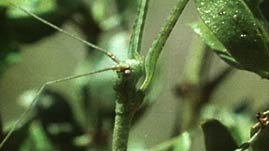Teachers' Domain - Digital Media for the Classroom and Professional Development
User: Preview

Source: Produced for Teachers' Domain
Masters of Disguise (Audio Description) (Video)
NARRATOR: Have you ever wanted to be invisible? Camouflage means disguise. Animals, from insects to mammals, use camouflage to blend into their surroundings, to hide from predators or to catch a meal.
This flounder hides easily on the sandy ocean floor. Only its eyes and gills move. When it swims to a place that looks different, it can change color to blend in again.
This crab decorates itself with bits of shell and rock. Such a costume helps it look like what it isn't...part of the ocean floor.
The alligator snapping turtle lives in the swamps of Florida. Its gray, brown, or black shell and skin match the color of the mud, making it very hard to see.
This horned lizard blends into the gravel of the anthill. It is almost invisible as it sticks out its tongue, lapping up ants as they hurry by.
This insect is called a walkingstick, and you can see why. When this green walkingstick moves, it looks like a twig shaking in the wind. Where its leg joins the body seems like any stem on the bush. Even the head of the walkingstick looks like a small bud.
Caterpillars are a favorite food for many birds. Birds look for leaves with bite marks, because there might be juicy caterpillars nearby. The most common caterpillar defense is not being seen at all. Being a careful eater is an advantage for this hornworm caterpillar. It covers its tracks by chewing the leaf evenly and quickly.
Then there's the dagger moth caterpillar. It actually hides behind a leaf as it eats. When most of the leaf is gone, the caterpillar chews through the stem, getting rid of the evidence. The leaf falls to the ground...joining the leftovers of other caterpillars in the area.
 Loading Standards
Loading Standards Teachers' Domain is proud to be a Pathways portal to the National Science Digital Library.
Teachers' Domain is proud to be a Pathways portal to the National Science Digital Library.
